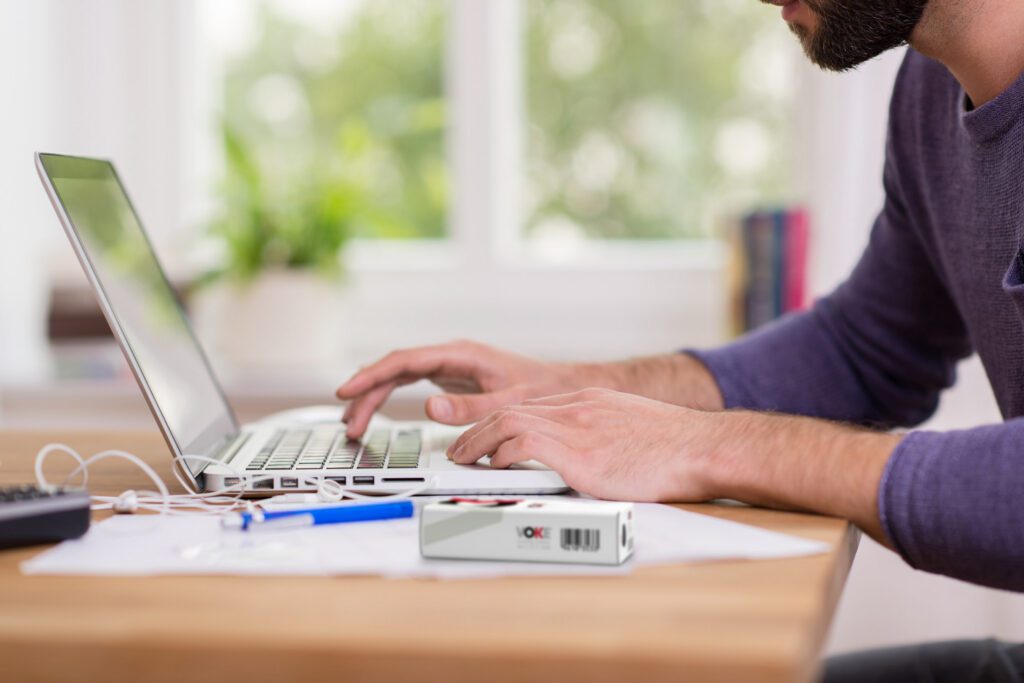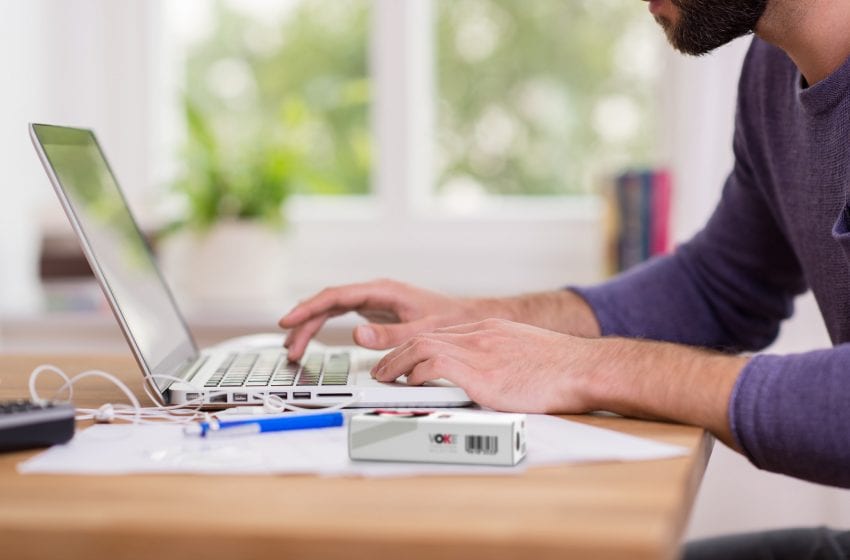
The Voke has no batteries and no electronics and therefore generates no heat and no chemical reactions.
By George Gay
This story it is not about vaping nor about a vapor device. Vapor devices can be described as electronic nicotine-delivery systems (ENDS); however, Voke is a nicotine inhalation device and does not fit into such a classification, except in the limited sense that it delivers nicotine.
Licensed by the U.K. Medicines and Healthcare products Regulatory Agency (MHRA) as a medicinal product that is a safer alternative to smoking, Voke can be usefully described as an alternative nicotine-delivery system that uses pharmaceutical-standard inhaler technology but offers it in a device that closely resembles a traditional cigarette in both the way it looks and in the way a consumer, in using the device, mimics most of the rituals of smoking. Voke has no batteries and no electronics and therefore generates no heat and no chemical reactions. It produces no smoke or vapor, just an invisible, odorless aerosol.
In theory at least, Voke should be a game-changer. It will be interesting to follow its fortunes on the market—to see how committed smokers and vapers are to the pursuit of reduced risk. It will also be interesting to watch the reaction of those opposed to smoking and, especially, those opposed to smoking and vaping. In the case of smokers and vapers, for instance, will they prove to be willing, in the name of risk reduction, to move from inhaling warm smoke or vapor to inhaling a cool aerosol? And what will tobacco control make of a device that is licensed to save lives?

TESTING THE COMMITMENT
For the time being, that commitment to risk reduction is being tested just among U.K. smokers. Alan Sutherland, the CEO of Kind Consumer, the independent, London-based healthcare research and development company that launched Voke in November, told Vapor Voice that the device was being made available only online at voke.com to people based in the U.K. who were over the age of 18. The online-only launch had been a deliberate choice, said Sutherland in an email reply. In that way, Kind could track and monitor initial consumer response and feedback, as well as ensure its manufacturing capability was able to keep abreast of demand as the company ran various consumer media tests.
Already, Kind has been promoted through a number of communication channels. “We have used this launch phase to test and trial various media vehicles from out of home (buses/train stations/bus shelters) to regional and national radio and most recently TV,” said Sutherland. “We have also now been cleared to advertise on Facebook as well as the London Underground where we just ran a campaign.”
While I have no experience in marketing, I would guess that Kind is hitting at least some of the right buttons. I learned about its launch from the man who owns the garage where I have my car serviced. He doesn’t smoke or vape but he is interested in the welfare of his mechanics, some of whom do smoke, vape or both.
Certainly, while these are early days, Kind is pleased with the response. “We are very happy with the results so far and especially by the growing level of repeat purchases,” said Sutherland. “Despite Covid-19, we are still seeing good online sales performance for Voke. In particular, people like the fact that Voke is licensed as a medicine by the Department for Health and Social Care as a safer alternative to smoking. Customers are also commenting positively on how quickly Voke reduces their nicotine cravings.”
In respect of sales, Sutherland said Kind was delivering ahead of its expectations, even though it had chosen to start cautiously. “We have had half a million visits on our site,” he said. “Conversion rates are good, and already, 23 percent of revenues are coming from repeat purchases, which is why we are confident to start scaling up now.”
In the short term, Kind’s capacity is about 5 million packs annually, but it could increase that to 35 million packs next year. The Voke pack, which has an underlying plastic structure and a paperboard cover that looks and feels like a cigarette pack, includes a canister containing a gas under pressure in liquid form that comprises medicinal-standard nicotine and slight menthol flavor masking along with a cigarette-like device. This device, which is filled from the canister, provides for a period of consumption that aligns with that of a traditional cigarette while one canister provides for about 20 “cigarette” refills, so there is plenty of continuity for cigarette smokers.
Also, in the short term, Kind says, it is focusing on expanding its U.K. business and, especially, trying to help smokers who are said by some to be more at risk than nonsmokers if they contract Covid-19. And there would seem to be a ready-made consumer base for Voke. “Research tells us more than 50 percent of smokers try to quit and fail, and more than one in five won’t try anymore because they believe it is too difficult,” Sutherland said. “We want to help them.”
There can be little doubt that Voke has some advantages over cigarettes and electronic cigarettes when it comes to sales channels. While the product has a medicine license that allows it to be prescribed by a doctor in the U.K., it also has an over-the-counter or general sales list label, so it can be sold anywhere from pharmacies to major retailers, corner shops and garage forecourts.
Additionally, despite the fact that Voke is not a vapor device, vape shops could prove to be an important sales channel since anyone who walks through the door of such an outlet is a person who has already decided to replace her smoking habit, or part of it, or who has at least decided to investigate doing so. And vape shops provide a space in which issues, such as Voke’s cool delivery, can be discussed.
BEYOND CESSATION
In the meantime, Kind is laying the groundwork for future international expansion, with a strong focus on the U.S., Europe and New Zealand, which aims to be smoke-free by 2025. Its U.K. medicine license can probably be leveraged in some other countries—with the notable exception of the U.S.—and, at the same time, there is no reason why Voke, under another name and possibly modified, could not be sold in other jurisdictions simply as a consumer product.
However, Kind’s ambitions go way beyond smoking cessation. It says it is intent on pioneering new technologies to improve public health and address some of the most significant global healthcare challenges in the 21st century. “Vaporless valve technology (VVT) presents an exciting new way of administering medicines into the body with a potential to reach into a range of therapeutic areas beyond smoking cessation alone,” said Sutherland.
It is not surprising that Kind wants to expand its areas of interest. The gestation period of Voke has been long and costly and has required a steep learning curve. Indeed, its appearance on the market can be seen as a remarkable act of faith.
A HARD SLOG
Kind was founded by Alex Hearn in 2006 with the aim of developing a safer alternative to cigarettes that would also address smokers’ psychological and physiological needs. Hearn is something of a polymath. He studied classics at Oxford University, is well read in science and has the sort of business acumen that led him to start an entrepreneurial body at Oxford whose model was adopted by other major universities in the U.K. and the U.S.
In 2009, Kind set out in earnest on the development of Voke, and, though it did not yet have a product, it soon found itself in a commercial bind. At that time, when e-cigarettes were still something of a novelty, it was believed that, under the then forthcoming revised EU Tobacco Products Directive, all vapor products sold in the EU would need to have a medicine license, but such a requirement fell by the wayside. So Voke, a device being developed at great expense within the constraints necessary to make it conform with a medicine license, was going to have to compete with devices developed at less expense without such constraints, a situation that one close observer described as “commercially challenging.”
It goes without saying that obtaining a medicine license, which Voke was granted only in 2014, was beyond challenging. And yet another major challenge arose in January 2017 when Kind and British American Tobacco, which had partnered with Kind in developing Voke, announced that they were going their separate ways. Kind, according to an announcement at the time, was going to take back ownership for the commercialization of Voke, allowing it to “embrace the full economics of the opportunity.”
It was an opportunity but also a challenge because Kind needed to find another partner, one that could help it scale up the manufacturing process, an undertaking that was bound to be costly given that the medical license meant the company’s processes, manufacturing operations and products were subject to the strictest protocols, were under the tightest scrutiny and had to be fully traceable.
Given this, it was not surprising that, in August 2018, Kind announced that Voke had been delayed getting to market by issues surrounding the scaling up of its manufacturing process, though the good news was that the company had raised further funding from existing and new investors—funding that would be used to complete the setup of state-of-the-art manufacturing capacity for Voke, which was and still is centered on two pharmaceutical facilities at Runcorn in the U.K. and Waterford in Ireland.
Having gone through so many challenges in getting Voke to market, it was something of a cruel irony that shortly afterward, the world was struck by a deadly coronavirus. But all is by no means lost. Kind has built up a three-month reserve of Voke in case manufacturing has to be interrupted. And though it seems callous to say so (and while Kind did not make any mention of this in its email), the coronavirus could have an upside in respect of demand for Voke simply because of the huge number of stories that are being published suggesting—with, I imagine, little evidence—that a smoker or vaper is more at risk than others of contracting Covid-19.
BECAUSE IT WORKS
In truth, Voke seems destined to be accepted because it works: It delivers a fast, effective and discreet craving relief that—and this surely is most important—can be enjoyed anywhere, anytime. This is a licensed medical device that produces no visible exhalation and produces no odor, so, a person could use it in the office, while on public transport, including airplanes, and while visiting a hospital. Of course, there is always a possibility that a business, perhaps an airline, might want to try to ban its use, though it is difficult to discern a rational reason why it might want to do so.
Unfortunately, however, this powerful use-anywhere argument is also perhaps the device’s weakest point because it is the point where it will be attacked by some in tobacco control concerned that a smoker will be able to use it to maintain his or her addiction in places where otherwise she or he would not be able to do so.
But this argument, often used against e-cigarettes, will surely be less effective in the case of Voke than in the case of other next-generation products. Firstly, because of the way that it delivers nicotine, Voke has to deliver only a low dose, 0.45 mg, from which, if the U.S. Food and Drug Administration is correct, it could be inferred that the new device creates a significantly lower risk of sustaining addiction than cigarettes or e-cigarettes.
Secondly, any addiction maintenance effect will surely be more than offset by the product’s use by some smokers to substitute completely for cigarettes and by others to transition away from tobacco and nicotine products altogether.
Finally, it is worth noting that Voke also offers a considerable advantage over lower risk tobacco/nicotine products and devices when it comes to the environment. As is mentioned above, Voke uses no battery, and it is a relatively simple device made of metal, card and plastic: materials that can be recycled. There’s no butts about it.


